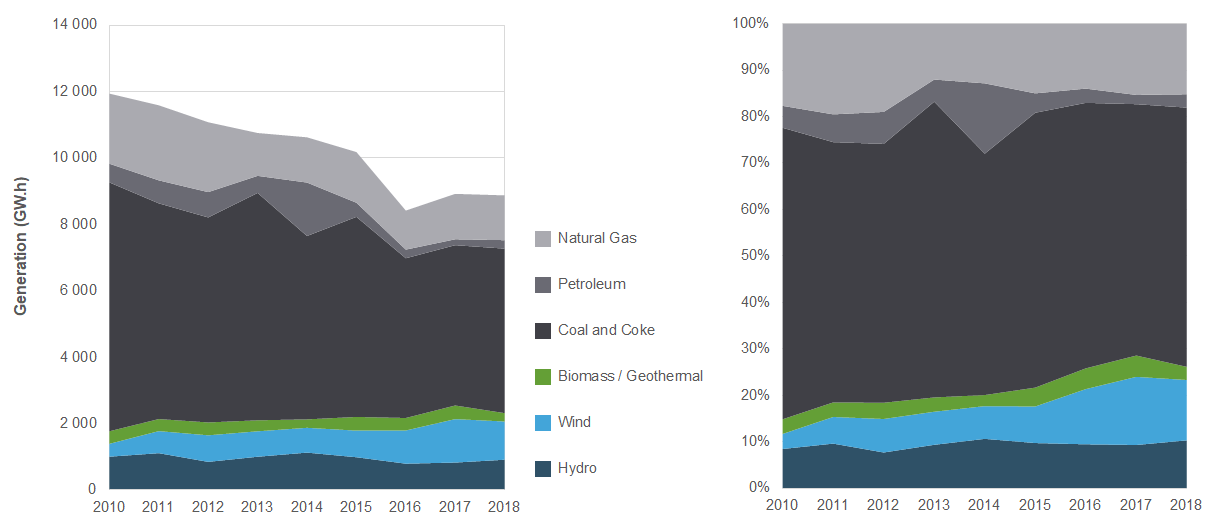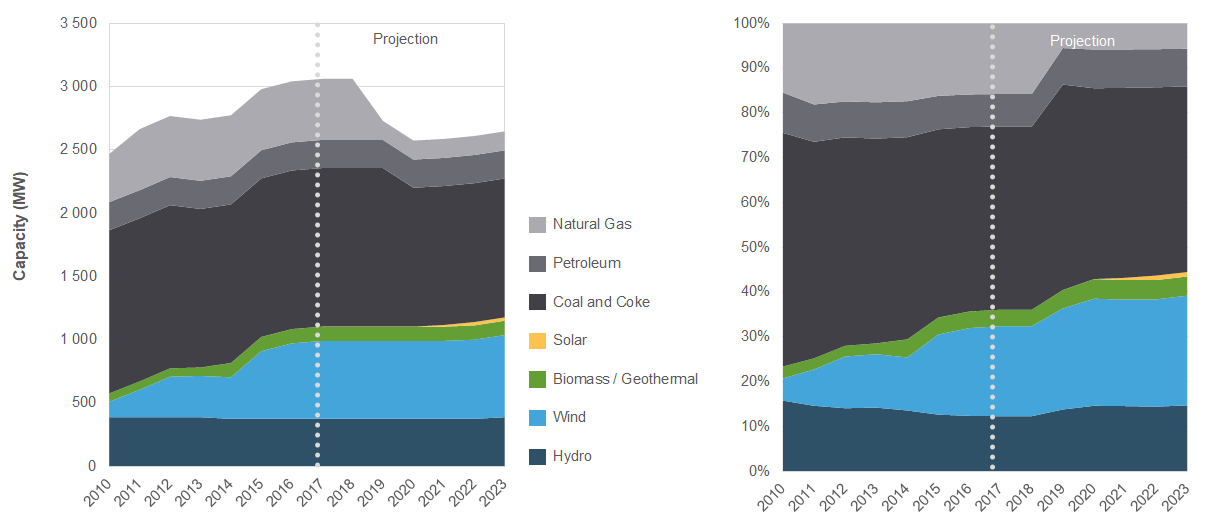Canada's Renewable Power – Nova Scotia

Nova Scotia

Nova Scotia generated one-quarter of its electricity from renewable sources in 2018. While fossil fuels (primarily coal) provide the remainder, the province plans to purchase hydroelectricity from Labrador’s Muskrat Falls to meet its renewable energy targets.
Generation Trends
In 2018, Nova Scotia generated 55.8% of its electricity from coal – the highest percentage in any province in Canada. Natural gas, oil, and diesel provided an additional 18.1%. Total thermal generation in 2018 was 6 558 gigawatt-hours (GW.h), or 73.9% of total generation.
Renewable electricity generation is growing in the province, led primarily by wind. In 2018, wind generated 1 153 GW.h, or 13.0% of Nova Scotia’s total generation. Hydro, tidal, and biomass contributed a combined 13.1% to total generation in 2018. Total renewable generation in 2018 was 2 319 GW.h, or 26.1% of total generation.
Nova Scotia is the only jurisdiction in North America to have commercially generated electricity from tidal energy. The Annapolis Tidal Station, on Nova Scotia’s Annapolis River came online in 1984 and generated roughly 33 GW.h per year. In 2019, Fisheries and Oceans Canada ordered the tidal station to shut down on fish mortality concerns.
In 2018, the proponents of Cape Sharp Tidal project withdrew their support of the project after the turbine was damaged beyond repair. In 2020, BigMoon Canada Corporation was selected to construct eight 0.5 megawatt (MW) turbines in the Bay of Fundy and remove the Cape Sharp turbine. BigMoon has until 31 December 2024 to remove the abandoned turbine.
Nova Scotia’s legislated renewable energy targets require 40% of electricity to be generated from renewable sources by the end of 2020. A key element of reaching this target would be electricity purchases from the Muskrat Falls project in Labrador. Muskrat Falls had an initial start date of December 2017, but numerous project delays, including from COVID-19, have pushed that start date to September 2021.
Total electricity generation in Nova Scotia declined from 11 941 GW.h in 2010 to 8 877 GW.h in 2018. Changes in Nova Scotia’s electricity generation mix are illustrated in Figure 1.
Figure 1. Electricity Generation in Nova Scotia

Source and Description
Source: CER – Canada’s Energy Future 2020 (EF2020)
Description: This graph illustrates electricity generation from 2010 to 2018 in Nova Scotia. In 2010, Nova Scotia’s total generation was 11 941 GW.h (14.8% renewable). In 2018, total generation was 8 877 GW.h (26.1% renewable).
GHG Emissions from Electricity Generation
In 2018, Nova Scotia’s electricity sector emitted 7.0 megatonnes of carbon dioxide equivalent (MT of CO2e). Nova Scotia’s generation intensity was 720 grams of CO2e per kilowatt-hour.
Nova Scotia produced 10% of Canada’s total greenhouse gas emissions from electricity generation in 2018.
Recent and Projected Capacity Changes for Renewables
Between 2010 and 2017, Nova Scotia added a net 527 MW of renewable capacity, primarily in the form of wind (493 MW). Between 2017 and 2023, Nova Scotia is projected to add 73 MW of new net renewable capacity from hydro, wind, and solar. These capacity changes are illustrated in Figure 2 with data provided in Table 1.
Nova Scotia is also currently exploring opportunities for new tidal energy. The province’s Marine Renewable-energy Act was passed in 2017 and amended in 2019 to offer a framework for the development of marine renewable energy resources in Nova Scotia’s offshore. Though an estimated 2 500 MW of capacity could be achieved without significant effects on the marine environment, the province is aiming for a goal of 15 to 20 MW initially with a long-term goal of 300 MW.
Figure 2. Electricity Capacity and Future Changes in Nova Scotia

Source and Description
Source: CER – EF2020
Description: This graph illustrates historical electricity capacity from 2010 to 2017 in Nova Scotia and the CER’s projection of future capacity changes from 2018 to 2023. In 2010, Nova Scotia’s total installed electricity capacity was 2 469 MW (23.4% renewable). In 2017, capacity had grown to 3 061 MW (36.1% renewable). By 2023, total capacity is projected to decline to 2 647 MW (44.5% renewable).
Table 1. Electricity Capacity (2010 – 2023) and Generation (2010 and 2018) in Nova Scotia
| Capacity in MW and % | Generation in GW.h and % | ||||||
|---|---|---|---|---|---|---|---|
| 2010 | 2017 | 2018 | 2020 | 2023 | 2010 | 2018 | |
| ---------- Projected ---------- | |||||||
| Hydroelectricity | 389 | 376 | 376 | 376 | 389 | 1 008 | 914 |
| 15.8% | 12.3% | 12.3% | 14.6% | 14.7% | 8.4% | 10.3% | |
| Wind | 122 | 615 | 615 | 615 | 648 | 387 | 1 153 |
| 4.9% | 20.1% | 20.1% | 23.9% | 24.5% | 3.2% | 13.0% | |
| Biomass / Geothermal | 66 | 113 | 113 | 113 | 113 | 378 | 251 |
| 2.7% | 3.7% | 3.7% | 4.4% | 4.3% | 3.2% | 2.8% | |
| Solar | 0.0 | 0.4 | 0.4 | 0.4 | 26.4 | 0.0 | 0.0 |
| 0.0% | 0.0% | 0.0% | 0.0% | 1.0% | 0.0% | 0.0% | |
| All Renewable Sources | 578 | 1 105 | 1 105 | 1 105 | 1 177 | 1 773 | 2 319 |
| 23.4% | 36.1% | 36.1% | 42.9% | 44.5% | 14.8% | 26.1% | |
| Coal and Coke | 1 288 | 1 252 | 1 252 | 1 097 | 1 097 | 7 493 | 4 955 |
| 52.2% | 40.9% | 40.9% | 42.6% | 41.4% | 62.8% | 55.8% | |
| Natural Gas | 381 | 482 | 482 | 150 | 150 | 2 111 | 1 349 |
| 15.4% | 15.7% | 15.7% | 5.8% | 5.7% | 17.7% | 15.2% | |
| Oil and Diesel | 222 | 222 | 222 | 222 | 222 | 564 | 254 |
| 9.0% | 7.3% | 7.3% | 8.6% | 8.4% | 4.7% | 2.9% | |
| All Thermal Sources | 1 891 | 1 956 | 1 956 | 1 469 | 1 469 | 10 168 | 6 558 |
| 76.6% | 63.9% | 63.9% | 57.1% | 55.5% | 85.2% | 73.9% | |
| All Sources | 2 469 | 3 061 | 3 061 | 2 574 | 2 647 | 11 941 | 8 877 |
- Date modified:
